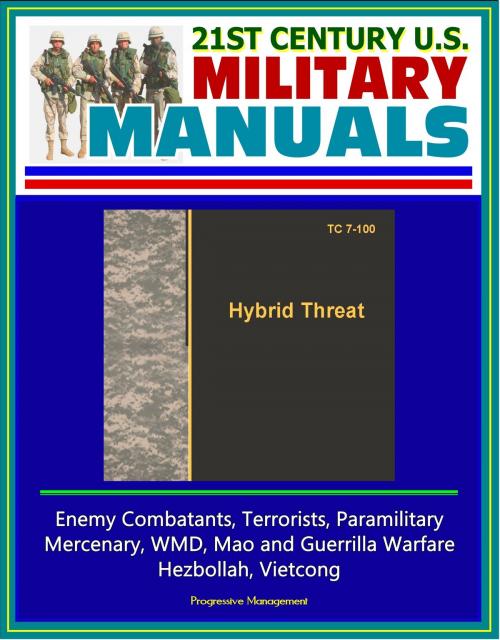21st Century U.S. Military Manuals: Hybrid Threat (TC 7-100) - Enemy Combatants, Terrorists, Paramilitary, Mercenary, WMD, Mao and Guerrilla Warfare, Hezbollah, Vietcong
Nonfiction, History, Military, United States, Social & Cultural Studies, Political Science| Author: | Progressive Management | ISBN: | 9781310516351 |
| Publisher: | Progressive Management | Publication: | June 29, 2014 |
| Imprint: | Smashwords Edition | Language: | English |
| Author: | Progressive Management |
| ISBN: | 9781310516351 |
| Publisher: | Progressive Management |
| Publication: | June 29, 2014 |
| Imprint: | Smashwords Edition |
| Language: | English |
A hybrid threat is the diverse and dynamic combination of regular forces, irregular forces, and/or criminal elements all unified to achieve mutually benefitting effects.
The purpose of this training circular (TC) is to describe hybrid threats and summarize the manner in which such future threats may operationally organize to fight U.S. forces. It also outlines the strategy, operations, tactics, and organization of the Hybrid Threat that represents a composite of actual threat forces as an opposing force (OPFOR) for training exercises.
Topics and subjects covered include: Enemy combatants, terrorists, paramilitary, mercenary, WMD, Mao and guerrilla warfare, Hezbollah, Vietcong.
This TC will address an emerging category of threats and activities that do not fit into the traditional understanding of conventional and unconventional war. It will focus on hybrid threats as simultaneous combinations of various types of activities by enemies and adversaries that will change and adapt over time. This TC summarizes the manner in which future threats operationally organize to fight us. However, it also discusses the strategy, operations, tactics, and organizations of the Hybrid Threat (HT), which portrays such forces in training exercises. For more detailed discussions of HT operations, tactics, and organizations, the reader should consult other TCs in the 7-100 series and supporting products.
PREFACE * INTRODUCTION * Hybrid Threats and the Hybrid Threat for Training * The Emergence of Hybrid Threats * Major Combat Operations * Multiple Threats * PART ONE - HYBRID THREATS * Chapter 1 - HYBRID THREAT CONCEPTS * Hybrid Threats * Hybrid Adaptation * Hybrid Transitions * Chapter 2 - HYBRID THREAT COMPONENTS * Threats and Other Actors * Defining Enemy Combatants * Use of WMD * PART TWO - THE HYBRID THREAT FOR TRAINING * Chapter 3 - HYBRID THREAT STRATEGY * Strategic Operations * Strategic Information Warfare * Strategic Preclusion * Chapter 4 - HYBRID THREAT OPERATIONS * Operational Designs * Regional Operations * Transition Operations * Adaptive Operations * Principles of Operation versus an Extraregional Power * Chapter 5 - HYBRID THREAT TACTICS * Tactical Concepts * Functional Tactics * Chapter 6 - HYBRID THREAT ORGANIZATIONS * Task-Organizing * Military Organizations * Insurgent Organizations * Guerrilla Organizations * Criminal Organizations * Hybrid Relationships * Appendix A SCENARIO BLUEPRINTS * Scenario Blueprint Concept * Exercise Design * Scenario Blueprint Example
The term "hybrid" has recently been used to capture the seemingly increased complexity of war, the multiplicity of actors involved, and the blurring between traditional categories of conflict. While the existence of innovative adversaries is not new, today's hybrid approaches demand that U.S. forces prepare for a range of conflicts. These may involve nation-state adversaries that employ protracted forms of warfare, possibly using proxy forces to coerce and intimidate, or non-state actors using operational concepts and high-end capabilities traditionally associated with states. The emergence of hybrid threats heralds a dangerous development in the capabilities of what was labeled a "guerrilla" or "irregular" force in past conflicts. Hybrid threats can combine state-based, conventional military forces—sophisticated weapons, command and control, and combined arms tactics—with attributes usually associated with insurgent and criminal organizations. Hybrid threats are characterized by the combination of regular and irregular forces.
A hybrid threat is the diverse and dynamic combination of regular forces, irregular forces, and/or criminal elements all unified to achieve mutually benefitting effects.
The purpose of this training circular (TC) is to describe hybrid threats and summarize the manner in which such future threats may operationally organize to fight U.S. forces. It also outlines the strategy, operations, tactics, and organization of the Hybrid Threat that represents a composite of actual threat forces as an opposing force (OPFOR) for training exercises.
Topics and subjects covered include: Enemy combatants, terrorists, paramilitary, mercenary, WMD, Mao and guerrilla warfare, Hezbollah, Vietcong.
This TC will address an emerging category of threats and activities that do not fit into the traditional understanding of conventional and unconventional war. It will focus on hybrid threats as simultaneous combinations of various types of activities by enemies and adversaries that will change and adapt over time. This TC summarizes the manner in which future threats operationally organize to fight us. However, it also discusses the strategy, operations, tactics, and organizations of the Hybrid Threat (HT), which portrays such forces in training exercises. For more detailed discussions of HT operations, tactics, and organizations, the reader should consult other TCs in the 7-100 series and supporting products.
PREFACE * INTRODUCTION * Hybrid Threats and the Hybrid Threat for Training * The Emergence of Hybrid Threats * Major Combat Operations * Multiple Threats * PART ONE - HYBRID THREATS * Chapter 1 - HYBRID THREAT CONCEPTS * Hybrid Threats * Hybrid Adaptation * Hybrid Transitions * Chapter 2 - HYBRID THREAT COMPONENTS * Threats and Other Actors * Defining Enemy Combatants * Use of WMD * PART TWO - THE HYBRID THREAT FOR TRAINING * Chapter 3 - HYBRID THREAT STRATEGY * Strategic Operations * Strategic Information Warfare * Strategic Preclusion * Chapter 4 - HYBRID THREAT OPERATIONS * Operational Designs * Regional Operations * Transition Operations * Adaptive Operations * Principles of Operation versus an Extraregional Power * Chapter 5 - HYBRID THREAT TACTICS * Tactical Concepts * Functional Tactics * Chapter 6 - HYBRID THREAT ORGANIZATIONS * Task-Organizing * Military Organizations * Insurgent Organizations * Guerrilla Organizations * Criminal Organizations * Hybrid Relationships * Appendix A SCENARIO BLUEPRINTS * Scenario Blueprint Concept * Exercise Design * Scenario Blueprint Example
The term "hybrid" has recently been used to capture the seemingly increased complexity of war, the multiplicity of actors involved, and the blurring between traditional categories of conflict. While the existence of innovative adversaries is not new, today's hybrid approaches demand that U.S. forces prepare for a range of conflicts. These may involve nation-state adversaries that employ protracted forms of warfare, possibly using proxy forces to coerce and intimidate, or non-state actors using operational concepts and high-end capabilities traditionally associated with states. The emergence of hybrid threats heralds a dangerous development in the capabilities of what was labeled a "guerrilla" or "irregular" force in past conflicts. Hybrid threats can combine state-based, conventional military forces—sophisticated weapons, command and control, and combined arms tactics—with attributes usually associated with insurgent and criminal organizations. Hybrid threats are characterized by the combination of regular and irregular forces.















